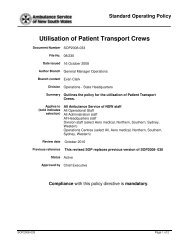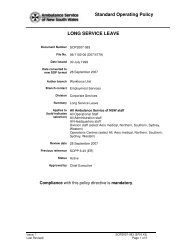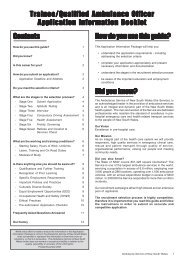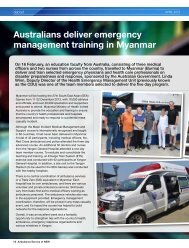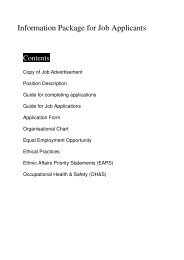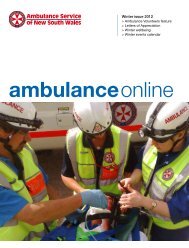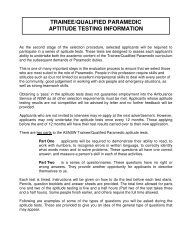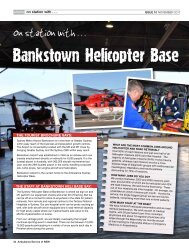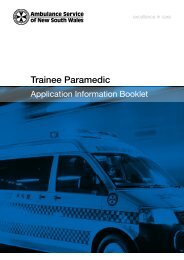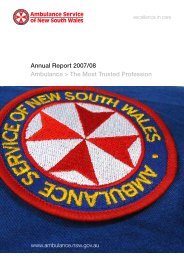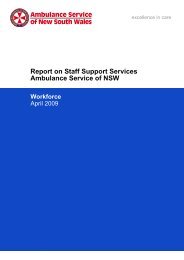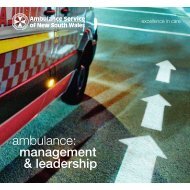atsb final report released 16 may 2013 - Ambulance Service of NSW
atsb final report released 16 may 2013 - Ambulance Service of NSW
atsb final report released 16 may 2013 - Ambulance Service of NSW
You also want an ePaper? Increase the reach of your titles
YUMPU automatically turns print PDFs into web optimized ePapers that Google loves.
CommunicationDuring the course <strong>of</strong> the mission, there were several occasions where radiocommunication was unable to be established between relevant parties. However, all<strong>of</strong> the flight crew and personnel on the ground were able to successfullycommunicate via radio at some stage, including the pilot with the duty paramedicand the support paramedic with the crew <strong>of</strong> ‘Rescue 23’. It was thereforeconsidered unlikely that there were any technical issues with the respective radios.More probably, there appear to have been either environmental (for example, terrainshielding or ambient noise) or equipment operator-related issues that adverselyinfluenced this capability.The ACM’s unfamiliarity with the use <strong>of</strong> the helicopter’s radios prevented hiscommunication with the paramedics and resulted in the use <strong>of</strong> hand signals tocommunicate with the duty paramedic. The fact that the paramedic and the injuredcanyoner connected to the rescue hook indicated that they intended to continue thewinch as planned. In that context, whether the ACM misinterpreted the dutyparamedic’s movement as a signal that he was ready to be winched, or if he actuallydid indicate ‘ready’, from this point the other factors that led to the fall wouldprobably still have occurred.Finally, although the support paramedic could not establish communication with theflight crew after the fall, based on the above survivability considerations,knowledge <strong>of</strong> what had occurred would likely not have enabled him to change theoutcome for the duty paramedic. However, it would have permitted the supportparamedic to access the duty paramedic earlier and provide pain relief and comfort.Organisational influenceAccess to the injured canyoner was achieved using established procedures withwhich the SCAT paramedics and flight crew were all familiar. The planned retrieval<strong>of</strong> the canyoner, although based on the Hi-line transfer procedure, involvedadaptation to allow for the delivery <strong>of</strong> the winch hook and for a stabilising ropesystem. As such, the retrieval plan involved the use <strong>of</strong> techniques that were neitherdocumented nor trained for by the operator or <strong>Ambulance</strong> <strong>Service</strong> <strong>of</strong> <strong>NSW</strong>(AS<strong>NSW</strong>) personnel. In addition, in the opinion <strong>of</strong> AS<strong>NSW</strong> management, the use<strong>of</strong> a self-stabilising rope system had not been previously undertaken and was notendorsed. The operator also <strong>report</strong>ed that any variations to the procedures in itsoperations manual were not endorsed.Despite the <strong>report</strong>ed positions <strong>of</strong> AS<strong>NSW</strong> and the operator, the crew’s willingnessto adapt known techniques <strong>may</strong> have been due to their familiarity with the Hi-linetransfer procedure, resulting in the crew viewing the plan for the retrieval as similarto an approved and known procedure. This willingness <strong>may</strong> also have beeninfluenced by the pilot’s and paramedic’s <strong>report</strong>ed awareness <strong>of</strong> previous similarjobs, as discussed during the planning for the recovery <strong>of</strong> the injured canyoner.Both AS<strong>NSW</strong> management and a number <strong>of</strong> SCAT paramedics advised that SCAT<strong>of</strong>ficers are trained in a number <strong>of</strong> access procedures and the use <strong>of</strong> the associatedequipment. That training is then applied or adapted to the mission at hand. Forexample, SCAT personnel have been involved in a number <strong>of</strong> visually spectacularhelicopter rescues that were well known within the SCAT paramedic community,including the one referred to by the duty paramedic during the crew’s planning to- 41 -



